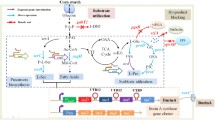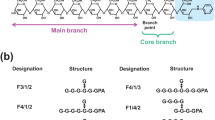Abstract
In order to produce rubusoside, enzymes with preferential specificity for the saccharide sophorose were tested for ability to produce rubusoside from stevioside. We identified BGL1, a β-glucosidase from Streptomyces sp. GXT6, as an enzyme for rubusoside production. Out of several saccharide substrates, BGL1 showed the most affinity to sophorose. This enzyme only hydrolyzes the glucose moiety of the sophoroside at C-13 in stevioside. Production of rubusoside was determined by 1H and 13C nuclear magnetic resonance (NMR). Thus, rubusoside was produced from stevioside and the stevioside conversion rate was 98.2 %. The production yield of rubusoside was 78.8 % in 6 h.




Similar content being viewed by others
References
Ceunen S, Geuns JM (2013) Steviol glycosides: chemical diversity, metabolism, and function. J Nat Prod 76(6):1201–1228
Chen J-M, Xia Y-M, Wan H-D, Wang H-J, Liu X (2014) A complete specific cleavage of glucosyl and ester linkages of stevioside for preparing steviol with a β-galactosidase from Sulfolobus solfataricus. J Mol Catal B-Enzym 105:126–131
Chou G, Xu SJ, Liu D, Koh GY, Zhang J, Liu Z (2009) Quantitative and fingerprint analyses of Chinese sweet tea plant (Rubus suavissimus S. Lee). J Agric Food Chem 57(3):1076–1083
Du L, Wang Z, Zhao Y, Huang J, Pang H, Wei Y, Lin L, Huang R (2014) A beta-glucosidase from Novosphingobium sp. GX9 with high catalytic efficiency toward isoflavonoid glycoside hydrolysis and (+)-catechin transglycosylation. Appl Microbiol Biotechnol 98(16):7069–7079
Geuns J (2003) Stevioside. Phytochemistry 64(5):913–921
Ko JA, Kim YM, Ryu YB, Jeong HJ, Park TS, Park SJ, Wee YJ, Kim JS, Kim D, Lee WS (2012) Mass production of rubusoside using a novel stevioside-specific beta-glucosidase from Aspergillus aculeatus. J Agric Food Chem 60(24):6210–6216
Ko JA, Ryu YB, Kwon HJ, Jeong HJ, Park SJ, Kim CY, Wee YJ, Kim D, Lee WS, Kim YM (2013) Characterization of a novel steviol-producing beta-glucosidase from Penicillium decumbens and optimal production of the steviol. Appl Microbiol Biotechnol 97(18):8151–8161
Koh GY, Chou G, Liu Z (2009) Purification of a water extract of Chinese sweet tea plant (Rubus suavissimus S. Lee) by alcohol precipitation. J Agric Food Chem 57(11):5000–5006
Liu Z, Schwimer J, Liu D, Lewis J, Greenway FL, York DA, Woltering EA (2006) Gallic acid is partially responsible for the antiangiogenic activities of Rubus leaf extract. Phytother Res 20(9):806–813
Miller GL (1959) Use of dinitrosalicylic acid reagent for determination of reducing sugar. Anal Chem 31(3):426–428
Nakano H, Okamoto K, Yatake T, Kiso T, Kitahata S (1998) Purification and characterization of a novel β-glucosidase from Clavibacter michiganense that hydrolyzes glucosyl ester linkage in steviol glycosides. J Ferment Bioeng 85(2):162–168
Nguyen TT, Jung SJ, Kang HK, Kim YM, Moon YH, Kim M, Kim D (2014) Production of rubusoside from stevioside by using a thermostable lactase from Thermus thermophilus and solubility enhancement of liquiritin and teniposide. Enzyme Microb Technol 64–65:38–43
Okamoto K, Nakano H, Yatake T, Kiso T, Kitahata S (2000) Purification and some properties of a β-glucosidase from Flavobacterium johnsonae. Biosci Biotechnol Biochem 64(2):333–340
Prakash Chaturvedula VS, Prakash I (2011) A New diterpene glycoside from Stevia rebaudiana. Molecules 16(4):2937–2943
Wan H-D, Tao G-J, Kim D, Xia Y-M (2012) Enzymatic preparation of a natural sweetener rubusoside from specific hydrolysis of stevioside with β-galactosidase from Aspergillus sp. J Mol Catal B-Enzym 82:12–17
Zhang F, Koh GY, Hollingsworth J, Russo PS, Stout RW, Liu Z (2012) Reformulation of etoposide with solubility-enhancing rubusoside. Int J Pharm 434(1-2):453–459
Acknowledgments
This work was supported by the National Natural Science Foundation of China (No. 31360369, 21366007), the Innovation Project of Guangxi Graduate Education (No. YCBZ2015005) and the Natural Science Foundation of Guangxi (No. 2014GXNSFAA118097).
Conflict of interest
The authors declare that they have no conflicts of interest.
Author information
Authors and Affiliations
Corresponding authors
Electronic supplementary material
Below is the link to the electronic supplementary material.
ESM 1
(PDF 6068 kb)
Rights and permissions
About this article
Cite this article
Wang, Z., Wang, J., Jiang, M. et al. Selective production of rubusoside from stevioside by using the sophorose activity of β-glucosidase from Streptomyces sp. GXT6. Appl Microbiol Biotechnol 99, 9663–9674 (2015). https://doi.org/10.1007/s00253-015-6802-z
Received:
Revised:
Accepted:
Published:
Issue Date:
DOI: https://doi.org/10.1007/s00253-015-6802-z




